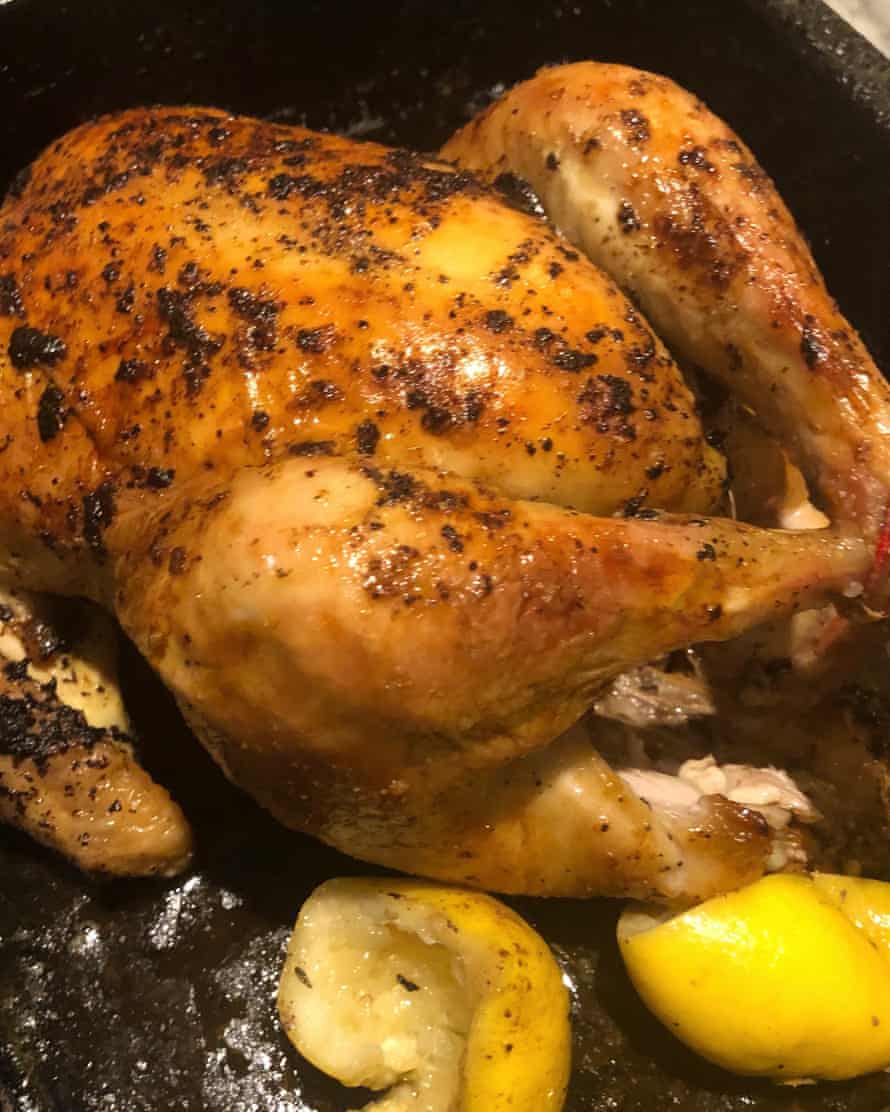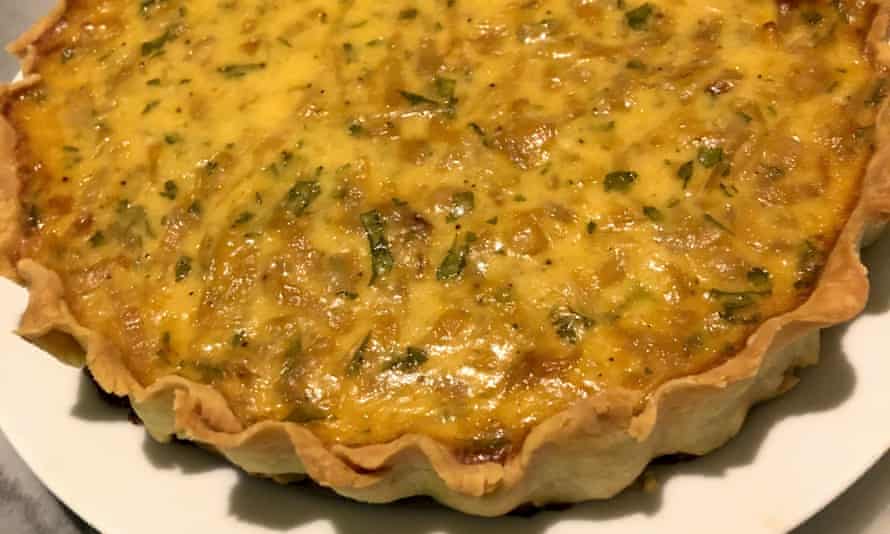If you’re going to do something that feels utterly filthy and wrong, it’s always good to believe you’re only following instructions. This is what I mutter to myself as I manipulate half a pat of room-temperature butter into a creamy overcoat for a raw chicken. I am only caking on the dairy fats because a cookbook has told me I must. I squeeze over the juice of a lemon, season liberally with salt and pepper, bang it into a hot oven and wait.
Cookbook titles tend towards the functional. It’s the food of this, or the book of that. And then there’s the best cookbook title of all time: Roast Chicken and Other Stories by Simon Hopkinson, with Lindsey Bareham. The second half of that sentence is perfect, for all recipes are indeed a story. The ingredients are the beginning. The method is the middle. We all know the ending. The best of those stories promise a better life. And then there is roast chicken, one of those tales that people like me love being told time and again.
When the book was first published in 1994, it was a much-adored volume by a young chef with a cult following, but it didn’t exactly trouble the bestseller lists. Lancashire-born Hopkinson had cooked professionally since he was 17, and served time as an Egon Ronay restaurant inspector before becoming head chef of Hilaire on London’s Brompton Road. There, he was talent spotted by the late Terence Conran for the 1987 opening of Bibendum, a wealthy man’s grandiose take on the best of French bistro food: oysters on the half-shell and snails in garlic butter, steak au poivre, rabbit with bacon and mustard sauce and a killer chocolate mousse. “I wrote most of the recipes for the book at Terence’s house in Provence, while we were preparing to open Bibendum,” Hopkinson says now.

During his time at Hilaire, Hopkinson had become friends with the Evening Standard restaurant critic Fay Maschler, who was also then writing recipes. She asked Hopkinson to stand in for her on the column, which led to him acquiring first an agent, and then a book commission from the ever-astute Jill Norman of Penguin. “But I was busy opening the restaurant,” Hopkinson says, a little sheepishly.
In the early 90s he admitted to his friend Lindsey Bareham, the food writer and one-time restaurant critic for Time Out, that he wasn’t getting anywhere with the much-delayed volume. “I told him he had to write it, because we all wanted his Bibendum recipes,” Bareham says. “I offered to help and a deal was done. He came to my house three times a week. I’d sit at my computer and he’d sit next to me. We’d chat and I’d write. Then we’d cook and eat.” The result is an elegantly compact volume with around 40 ingredients, listed in alphabetical order. Under “A” there’s anchovy, asparagus and aubergine, while C belongs to ceps, chocolate, cod and of course, chicken. There are half a dozen recipes or so for each, which lean heavily towards a rugged French repertoire.
Do you want a reliable recipe for a delightfully traditional pork terrine? Or a salade niçoise? Or petit salé aux lentilles? It’s here. While at Hilaire, Hopkinson had got to know the revered food writers Elizabeth David and Richard Olney, dishes from whom are also included. As a result, it acts as a golden thread, pulled through the post-Second World War history of encouraging food in Britain. Henry Harris worked with Hopkinson at Hilaire and was his head chef at Bibendum (before opening his own much-loved French restaurant, Racine). “It’s simply the most important cookbook of the last 25 years of the 20th century,” Harris says. “Many people had been doing their twists on these dishes. Simon restored them to their original selves.” Bareham agrees. “Simon likes doing dishes over and over again. They may not be original to him, but he perfects them.”
There are no glossy pictures, just sweet, delicate paintings of ingredients by Flo Bayley. The tone is set by Hopkinson’s introduction. “Buy wine to go with food. Come home. Have a glass of wine. Cook the food and eat with more of the wine.” Like the recipes themselves, he makes everything seem very straightforward.

In 2005, Waitrose Food Illustrated magazine ran an informal poll of cooks and food writers to find the most useful cookbook of all time. “Not the best,” says journalist William Sitwell, then the magazine’s editor. “The most useful.” The result made newspaper headlines. It wasn’t something by Jamie, or Gordon. The list was topped by Roast Chicken and Other Stories, pushing Delia’s Complete Cookery Course into second place. Nine years after publication the book became a massive bestseller, knocking Harry Potter off the top of the Amazon charts. “It contains recipes for food you really want to eat,” Sitwell says now. “And the book isn’t overly beautiful so you don’t mind getting it stained.”
I ask Hopkinson about the butter-caked roast chicken recipe, loosely based on that used at L’Ami Louis in Paris. “Well, that amount of butter was a feature of the time I wrote it,” he says. “I use much less now.” Instead of the 110g in the book, it’s a mere 75g. I’ve applied the full amount. It produces a lovely bird with crisp, bronzed skin and a fabulous buttery, lemony gravy. I also make his onion tart, which demands the sweating down of four large onions for well over an hour. It is a meditative process. The sweet, sloppy oniony mess is then mixed into a savoury custard. Hopkinson allows for additions, so I add a dollop of Dijon, a little grated parmesan and chopped flat-leaf parsley. A quick trip through the oven and I have a deep-filled, soft and extremely comforting tart.

I also make the Saint-Emilion au chocolat, which Hopkinson credits to Elizabeth David’s French Country Cooking. It’s meant to be a dark chocolate mousse, layered with fragments of brandy-soaked amaretti or macaroons, but I can find neither. I think of calling Hopkinson, but I can’t bring myself to admit my failure, so try boozy layers of madeira cake and broken chocolate-chip biscuits. The squares of cake float to the surface. I am ashamed of my handiwork. Then again it does taste fabulous. It’s a thing. If just not the thing. It does need Chantilly cream, or equivalent. The equivalent is Tesco Dairy Spray Cream. We’re in lockdown. Don’t demand an apology. I’ve had the roast chicken. This dessert is just one of those other stories.
Roast Chicken and Other Stories by Simon Hopkinson with Lindsey Bareham is published by Ebury at £22. Buy a copy for £20.02 from guardianbookshop.com
News bites
Cardiff’s Matsudai Ramen, by self-taught ‘ramen geek’ James Chant, has expanded distribution of its kits across the UK. There are four freezer kits including the vegan tantanmen, the shoyu and miso versions at £7.99 each. The fresh ramen kits, which include the sunset red tonkotsu and the new wave shoyu, cost around £20 for two servings, plus £6.95 for UK mainland delivery (matsudai.co.uk).
The shuttering of the restaurant industry has obviously had a massive impact on the network of companies supplying them: sauce-it.net is a new website aiming to hook consumers up with those suppliers. A series of virtual food halls contain stalls from seafood companies, Spanish produce suppliers, cheesemongers and so on. You can shop across them all into one basket. The user interface is a little complex, but the range is huge and by shopping there you’ll be helping struggling suppliers. Visit sauce-it.net.
A number of restaurants have branched out into merchandise as a money-making venture aimed at loyal customers who want to go beyond the joys of just eating the food. Now a website, LDNFoodMerch, has brought together these products from various London restaurants: you can get the Forza Win T-shirt, the Bao candle and a bunch of rather witty posters from Max’s Sandwich Shop, among other things. All revenue goes direct to the restaurants, visit ldnfoodmerch.com.
Email Jay at jay.rayner@observer.co.uk or follow him on Twitter @jayrayner1
from Lifestyle | The Guardian https://ift.tt/2N7iMrV
via IFTTT

comment 0 Comment
more_vert